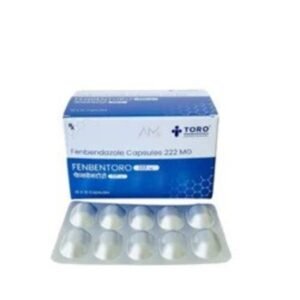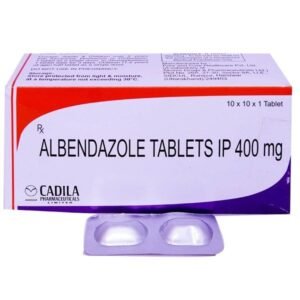ZBD 400 mg is a reliable broad-spectrum antiparasitic medication containing Albendazole, a trusted active ingredient doctors worldwide prescribe for decades to combat various worm infections. If you’ve ever experienced unexplained stomach pain, bloating, fatigue, poor appetite, or even seen signs of worms, you know how disruptive these hidden parasites can be—especially from contaminated food, water, or soil in everyday life.
ZBD 400 mg acts as a gentle yet powerful solution, helping eliminate these intruders so you can regain energy, comfort, and peace of mind. It’s particularly popular for routine deworming and treating more serious infections, backed by extensive clinical experience and guidelines from organizations like the WHO.
How ZBD 400 mg Works
Albendazole in ZBD 400 mg targets parasites by blocking their ability to absorb glucose—their main energy source. This starves the worms, causing them to become paralyzed and die, while your body safely expels them. It’s highly effective against both adult worms and larvae, preventing reinfestation, and shows proven results in studies with cure rates often exceeding 90-100% for common infections like roundworms and hookworms.
Key Features
- Active Ingredient: Albendazole 400 mg per tablet
- Form: Convenient oral tablet
- Packaging: Protective blister packs for freshness and easy dosing
- Quality: Manufactured under strict GMP standards, ensuring safety and potency
Common Uses: When Doctors Recommend ZBD 400 mg
Healthcare professionals prescribe this medication for a range of parasitic infections, based on established medical guidelines:
- Intestinal worms → such as roundworms (ascariasis), hookworms, whipworms, pinworms (enterobiasis), and threadworms
- Tapeworm infections
- Hydatid disease → (cysts from dog tapeworm larvae in liver, lungs, or other organs)
- Neurocysticercosis → (pork tapeworm larvae affecting the brain or tissues, often causing seizures)
- Other conditions → like cutaneous larva migrans or as part of mass deworming programs in endemic areas
It’s a staple in global health initiatives for soil-transmitted helminths, improving nutrition and growth, especially in children.
Dosage and Administration
Always consult your doctor for personalized advice—dosage varies by infection type, age, weight, and severity:
- For most common intestinal worms in adults and children over 2 years → A single 400 mg dose, often repeated after 2-3 weeks if needed.
- For hydatid disease → Typically 400 mg twice daily for 28 days, followed by a 14-day break (up to 3 cycles).
- For neurocysticercosis → 400 mg twice daily for 8-30 days, often with steroids to manage inflammation.
- Take with a fatty meal for better absorption → Swallow whole (or chew/crush for kids) with water.
Family-wide treatment is common since worms spread easily—your doctor may advise everyone in the household.
Side Effects: What to Know
Most people tolerate ZBD 400 mg well, especially with short courses. Mild, temporary effects may include:
- Nausea → vomiting, or abdominal pain
- Headache → dizziness
- Temporary hair loss → (it regrows)
- Fatigue
Rarely, longer treatments can affect liver function or blood counts—doctors monitor with tests for serious cases. Seek immediate help for severe allergies, seizures, or unusual symptoms. Experience from millions of doses shows it’s safe when used as directed.
Precautions and Important Advice
- Avoid during pregnancy → (especially first trimester) or breastfeeding unless benefits outweigh risks—it’s teratogenic in animal studies.
- Use caution with liver disease → bone marrow issues, or eye problems.
- Not for children under 2 years without specialist guidance.
- Inform your doctor about other medications to avoid interactions.
- Practice good hygiene → handwashing, proper cooking, clean water—to prevent reinfection.
Why Trust ZBD 400 mg?
With decades of real-world use, backed by experts at Mayo Clinic, CDC, and WHO, it’s a first-line choice for effective, affordable parasite control. Many people report feeling “lighter,” more energetic, and healthier soon after treatment—often with just one dose.
Never self-medicate for serious symptoms; get a proper diagnosis (e.g., stool test) and professional guidance for the best outcome.
FAQs
1. How quickly does ZBD 400 mg work?
It begins starving parasites within hours. Symptom improvement often starts in 2-5 days, with full clearance taking a week or more depending on the infection.
2. Is ZBD 400 mg safe for children?
Yes, for children over 2 years—a single 400 mg dose is standard for many worms. For younger kids, consult a pediatrician for adjusted dosing or alternatives.
3. Can I use ZBD 400 mg for routine deworming without symptoms?
In high-risk areas, doctors often recommend periodic single doses even without symptoms, per WHO guidelines. Always confirm with your healthcare provider.
4. What if I miss a dose?
Take it as soon as remembered, but don’t double up. For single-dose regimens, it’s usually not a problem—just follow up as advised.
5. Are there food or drink restrictions?
Take with food (ideally fatty) for optimal absorption. Avoid alcohol, as it may worsen side effects like dizziness.
6. Does ZBD 400 mg prevent future infections?
It clears current parasites effectively but doesn’t provide long-term prevention. Focus on hygiene, safe water, and food practices for ongoing protection.
If parasitic symptoms are affecting you or your family, speak to a doctor today—ZBD 400 mg could be the straightforward path back to feeling great!
| Zbd 400mg | 30 Tablets $50, 50 Tablets $80, 100 Tablets $140, 300 Tablets $290 |
|---|
You must be logged in to post a review.








Reviews
There are no reviews yet.